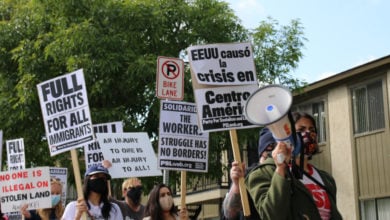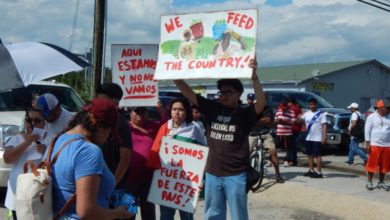On Aug. 15, over 1.7 million undocumented immigrants under 31 years old began applying for immigration protection called “deferred action for childhood arrivals.” The new program stemmed from President Obama’s June 15 announcement that the Department of Homeland Security would begin offering the two-year immigration protection, as well as work authorization, to those who would have been eligible for benefits under the stalled Development, Relief, and Education for Alien Minors Act.
Yet for the approximately 10 million or more undocumented immigrants in the United States who do not qualify for DACA, the Aug. 15 date meant more years living in the shadows. With no Social Security number, and under constant threat of deportation and family separation, the millions ineligible for DACA still struggle against the daily oppression of life as undocumented workers. Most importantly, the youth who won access to DACA protection continue to wage the struggle for full rights not only for themselves but for all immigrants.
While the DACA program is broad enough to allow many to apply for work authorization, the eligibility requirements are very strict and limited. Anyone who did not arrive in the United States before his or her 16th birthday is not eligible. Anyone 31 years old or older as of June 15, 2012, is not eligible—nearly 7 million undocumented immigrants are over age 31. Anyone who left the United States for a significant period over the last five years may not be eligible. Even minor, non-violent criminal convictions, such as three or more misdemeanor traffic violations or even one conviction for driving under the influence could disqualify a person from any protection. It also does not confer lawful status or provide any pathway to citizenship.
DACA is also a temporary measure that lasts for two years, but is potentially extendable by the Department of Homeland Security. This leaves the lives of immigrants and their families hanging on political decisions that will be made years down the line. For now, those eligible have protection, but DACA will now be used as a bargaining chip in political campaigning for as long as it continues.
Nevertheless, the DACA program may provide immigration protection for more applicants than any other program in decades. Despite its significant drawbacks, the program signifies the growing strength of the movement for immigrant rights, especially among undocumented immigrant youth.
In Chicago, it is estimated that 50,000 lined up for one DACA legal assistance clinic. Young people began lining up the night before, waiting outside so they could be among the first to meet with a lawyer. Organizers had anticipated as many as 5,000 applicants, but by 9 a.m., 12,000 people were already waiting in line. Ultimately, the line was so long that it took 30 minutes just to walk from one end to the other.
Even with these great numbers applying, immigrants view the program with justified caution. Undocumented parents express both elation and worry, realizing that the program is not permanent and does not protect family units. One 43-year-old undocumented father from El Salvador explained, “I am happy because our children may be eligible to get a work permit … [b]ut it would be devastating to us to be away from our children.”
Meanwhile, the deportation machine has continued operating. While millions were applying for DACA, thousands more remained behind the bars of immigration detention, many fighting for their freedom with the help of DACA-eligible youth. The Obama administration has requested nearly $2 billion, or $5.4 million a day, for immigration detention operations in FY 2013.
Gov. Brewer of Arizona launches attack
There will be no peace for undocumented youth while families continue to be separated and deported. What is more, gains won are susceptible to right-wing attack of racist bigots like Gov. Jan Brewer of Arizona and her ilk. Within hours of the beginning of the DACA program, Brewer signed an executive order denying youth granted DACA access to state benefits like driver’s licenses, identification cards, and in-state tuition. Many undocumented youth who may qualify for DACA reside in Arizona.
With more than a little irony, undocumented activists pointed out that Brewer’s order stood in stark contrast to Obama’s “announcement”—a step short of an executive order, which could have forced DHS to stop deporting DACA-eligible youth.
In response, immigrant youth and allies mobilized protests, occupying the Arizona capitol overnight. Some of these activists had been organizers spearheading the fierce struggle against SB-1070 in 2010. In response to that racist law that sought to criminalize immigrants, people from all over the country descended on Arizona, refusing to leave the state capitol.
These actions spread around the country, leading to boycotts and the escalation of struggle against anti-immigrant state measures. In response, the Obama administration sued the state of Arizona and succeeded in striking down some of the provisions of the odious law.
The effects of this struggle have still not subsided—various anti-immigrant provisions of Alabama’s HB 56 and Georgia’s HB 87 were struck down by the 11th Circuit Federal Court of Appeals on Aug. 20. Nevertheless, courts have continued to allow local police to act as immigration agents, stopping and detaining people who are “suspected” to be undocumented.
“It seems like we’re repeating what we’ve already gone through,” explained 23-year-old Josh Montano, who has been living in the United States since he was eight months old. “But we can’t be moving backwards, we have to move forward.”
In a similar fashion to Arizona, Gov. Rick Perry of Texas advised state agencies that DACA did not confer any legal status on eligible immigrants, and reiterated the state’s policy of denying services to the undocumented.
The victory of DACA has shown that the status quo does not need to continue; immigration policy can change when the people most affected take to the streets to demand human rights and dignity. With undocumented immigrants fighting for full rights at the helm, the movement against detention and deportation can expand to a movement for full rights for immigrant families and workers, and ultimately a movement that joins with others to defeat racism and oppression.





